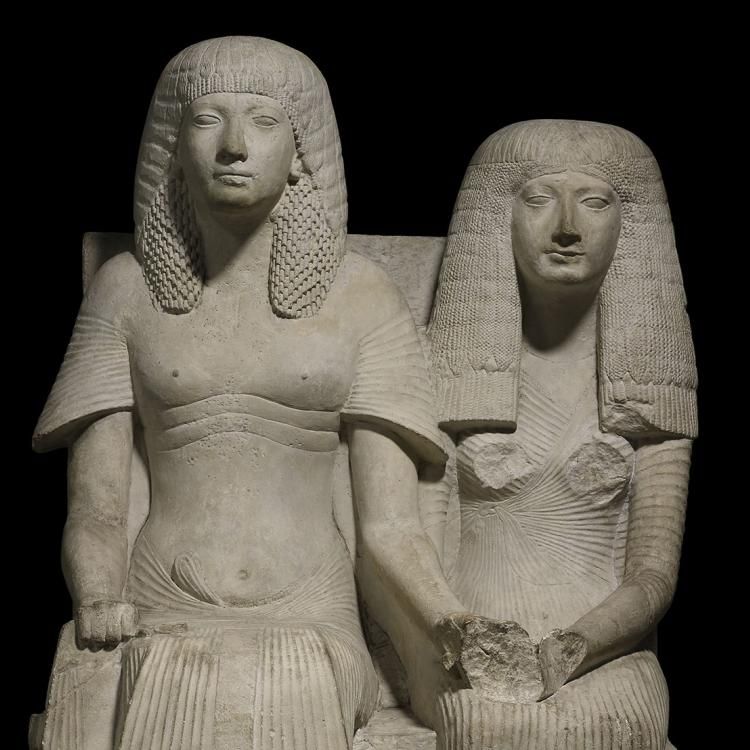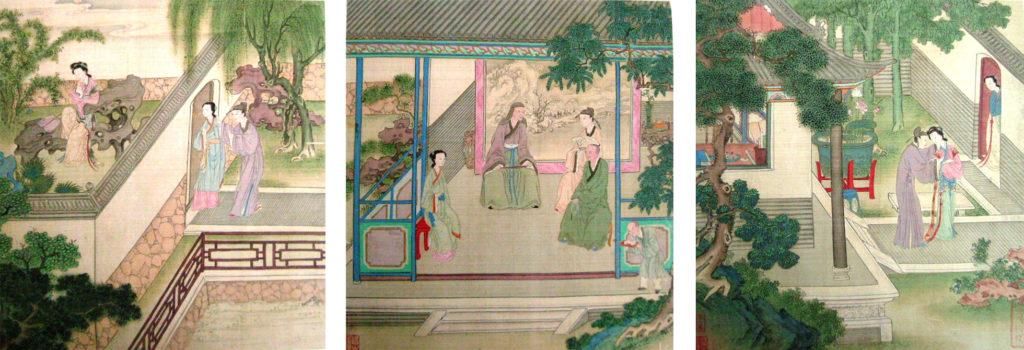Love is everywhere on Valentine's Day and the Museum is no exception. Join us on a tour of love stories from across the globe.
Love around the world
❤ It's Valentine's Day, and love is in the air at the Museum ❤
To celebrate, we've chosen eight love stories, ranging from a philosophical examination of the relationship between genders, to quiet moments of intimacy between great couples of the past.
Settle in for a whistle-stop tour of romance through the ages, from Civil War England to ancient Egypt.
Devotion between deities
The divine couple Shiva and Parvati sit in the centre of this intricate stone sculpture. In a display of tenderness and devotion, the Hindu deities are surrounded by heavenly musicians and garland-bearers. The sculpture was made in Odisha in the east of India and it articulates the belief that the universe is based on male and female principles.
Parvati is on the right. She is the goddess of love and fertility and brings balance to Shiva, whose untamed passion has the power to destroy worlds.
Below Shiva you can see the sage, Bhringi. According to myth, he was devoted to Shiva but neglected to worship Parvati. When Bhringi attempted to circle around Shiva as part of his worship, Parvati sat on Shiva’s lap to stress their unity.
Hadrian's heartbreak
Relationships between men were part of ancient Greek and Roman culture, at all levels of society. But Hadrian's love for Antinous appears to have been especially deep. Antinous, the Roman emperor Hadrian’s lover, drowned in the Nile while the imperial entourage was making a journey up the river in AD 130. By coincidence, Egyptians were commemorating the death, by drowning in the Nile, of the god Osiris on the same day.
Devastated, Hadrian founded a new city, Antinoopolis, at the site of his death. Antinous was venerated as the god Osiris-Antinous, and Hadrian also commissioned buildings and sculpture connected with the worship of Osiris for his villa in Tivoli, near Rome.
Both of these marble busts were made in the second century AD and were found in Rome. You can see the lovers together in Room 70.
Shoe love
These intricate, hand-stitched leather slippers (tarkasin) were designed for a bride and made in Libya in the late 20th century – probably in the 1960s or 1970s. They are embroidered with silk and would have formed an important part of the bride’s wedding trousseau (her wedding outfit or similar clothing).
The tongues are formed into the shape of a 'khamsa' or 'Hand of Fatima' to protect the wearer from the 'evil eye' or the 'eye of envy'. The metal studs were thought to repel harmful forces.
The 'Ladies of Llangollen'
In 1778, Lady Eleanor Butler and Sarah Ponsonby fled Ireland together. Challenging the conventions of the time, they set up home in North Wales, where they lived together for 50 years. Eleanor kept a diary which describes the days spent with her 'beloved' Sarah. The ladies became minor celebrities, living the life of their choice in the Welsh landscape.
These chocolate-cups belonged to the pair, and were made in the late 18th century. The image on the front depicts the cottage of the 'Ladies of Llangollen'.
Young lovers in China
The fictional tale of young lovers Cui Yingying and Zhang Sheng has frequently been depicted throughout history. The couple are characters in the play The Romance of the Western Chambers – a comedy written by Wang Shifu during the Chinese Yuan dynasty (1279–1368) – who embark on a secret love affair without the consent of their parents.
Scenes from the comedy appear in an album of beautifully detailed silk paintings from the eighteenth century. Above, on the right, you can see the young couple in the garden, while Cui Yingying's maid watches. Instead of exposing the lovers, the maid organises a secret union between them. The story ends on a positive note as the couple are 'officially' happily married.
Home is where the heart is
This ornate locket is known as the Grenville Jewel. The locket was sent from a loving husband – Sir Bevil Grenville – to his wife Lady Grace Grenville while the English Civil War kept them apart.
Inside we find Bevil's portrait, showing him wearing a suit of armour – during the Civil War he served as a Royalist general. He sent the jewel to his wife some time between 1639 and 1643 while away from home.
The outside of the locket is decorated with enamelled pansies, which were associated with loving thoughts at the time. Diamonds, emeralds, opals, rubies and pearls adorn its glittering exterior.
Let there be love
If bejewelled gifts between parted lovers isn't up your street, then this Maya stone lintel might be more your thing. It depicts a scene showing King Shield Jaguar II and his wife Lady Xoc.
The couple are seen engaged in a bloodletting rite. The king stands on the left with a flaming torch to illuminate the scene, while Lady Xoc kneels in front of him wearing an elaborately woven tunic. She pulls a rope, probably studded with obsidian blades, through her tongue, while blood falls into the bowl on the floor.
It would have originally been painted – the stone has traces of blue and red pigment. The text at the top of the panel reveals this event took place in October AD 709.
An Egyptian mystery, solved
This statue depicts a wealthy, well-dressed couple from ancient Egypt. Their stance is familiar and intimate as they sit on chairs with lion-paw feet. The statue was acquired in 1839, but the identity of the couple remained unknown for over 150 years.
At an excavation of the pharaoh Horemheb's tomb in 1976, a team of archaeologists uncovered a missing piece of the statue – the couple's clasped hands. In 2009 it was confirmed that the statue is of Horemheb, who commanded Egypt's armed forces under Tutankhamun before becoming pharaoh, and his wife Amenia.
The complete statue shows Amenia clasping her husband’s left hand in both of hers. It is an unusually tender and personal gesture, showing the couple deeply in love before Horemheb became pharaoh.
It might be a little late to get your significant other a Valentine's Day gift from our online shop, but our Museum-inspired range is sure to be a hit with the history lover in your life all year round.






